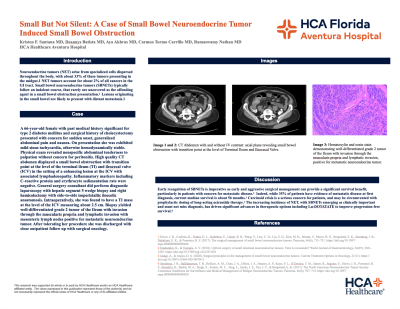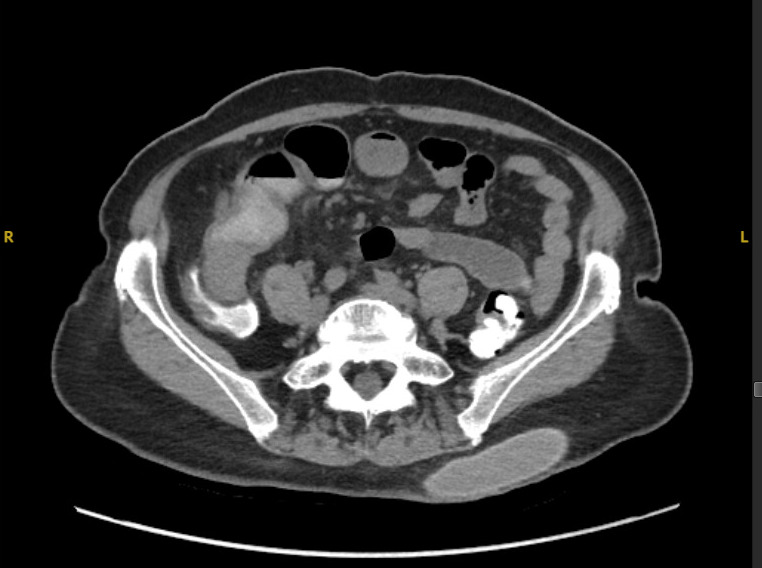Monday Poster Session
Category: Small Intestine
P3284 - Small But Not Silent: A Case of Small Bowel Neuroendocrine Tumor Induced Small Bowel Obstruction
Monday, October 28, 2024
10:30 AM - 4:00 PM ET
Location: Exhibit Hall E

Has Audio

Kristen Santana, MD
Aventura Hospital
Aventura, FL
Presenting Author(s)
Kristen Santana, MD1, Saadia Nabi, MD1, Ambar Sekulits, MD2, Luis G. Santiago Zayas, MD1, Ramasamy Nathan, MD1
1Aventura Hospital, Aventura, FL; 2Aventura Hospital, Dania Beach, FL
Introduction: Neuroendocrine tumors (NET) arise from specialized cells dispersed throughout the body, with about 33% of these tumors presenting in the midgut.1 NET tumors account for about 2% of all cancers in the GI tract. Small bowel neuroendocrine tumors (SBNETs) typically follow an indolent course, that rarely are uncovered as the offending agent in a small bowel obstruction presentation.2 Lesions originating in the small bowel are likely to present with distant metastasis.1
Case Description/Methods: A 66-year-old female with past medical history significant for type 2 diabetes mellitus and surgical history of cholecystectomy presented with concern for sudden onset, generalized abdominal pain and nausea. On presentation she was exhibited mild sinus tachycardia, otherwise hemodynamically stable. Physical exam revealed nonspecific abdominal tenderness to palpation without concern for peritonitis. High quality CT abdomen displayed a small bowel obstruction with transition point at the level of the terminal ileum (TI) and ileocecal valve (ICV) in the setting of a enhancing lesion at the ICV with associated lymphadenopathy. Inflammatory markers including C-reactive protein and erythrocyte sedimentation rate were negative. General surgery consultant did perform diagnostic laparoscopy with hepatic segment 5 wedge biopsy and right hemicolectomy with side-to-side isoperistaltic ileocolic anastomosis. Intraoperatively, she was found to have a TI mass at the level of the ICV measuring about 2.5 cm. Biopsy yielded well-differentiated grade 2 tumor of the Ileum with invasion through the muscularis propria and lymphatic invasion with mesenteric lymph nodes positive for metastatic neuroendocrine tumor. After tolerating her procedure she was discharged with close outpatient follow up with surgical oncology.
Discussion: Early recognition of SBNETs is imperative as early and aggressive surgical management can provide a significant survival benefit, particularly in patients with concern for metastatic disease.3 Indeed, while 35% of patients have evidence of metastatic disease at first diagnosis, current median survival is about 56 months.1 Carcinoid crisis is a serious concern for patients, and may be circumvented with prophylactic dosing of long-acting octreotide therapy.1 The increasing incidence of NET, with SBNETs emerging as clinically important and must not miss diagnosis, has driven significant advances in therapeutic options including Lu-DOTATATE to improve progression-free survival.4

Disclosures:
Kristen Santana, MD1, Saadia Nabi, MD1, Ambar Sekulits, MD2, Luis G. Santiago Zayas, MD1, Ramasamy Nathan, MD1. P3284 - Small But Not Silent: A Case of Small Bowel Neuroendocrine Tumor Induced Small Bowel Obstruction, ACG 2024 Annual Scientific Meeting Abstracts. Philadelphia, PA: American College of Gastroenterology.
1Aventura Hospital, Aventura, FL; 2Aventura Hospital, Dania Beach, FL
Introduction: Neuroendocrine tumors (NET) arise from specialized cells dispersed throughout the body, with about 33% of these tumors presenting in the midgut.1 NET tumors account for about 2% of all cancers in the GI tract. Small bowel neuroendocrine tumors (SBNETs) typically follow an indolent course, that rarely are uncovered as the offending agent in a small bowel obstruction presentation.2 Lesions originating in the small bowel are likely to present with distant metastasis.1
Case Description/Methods: A 66-year-old female with past medical history significant for type 2 diabetes mellitus and surgical history of cholecystectomy presented with concern for sudden onset, generalized abdominal pain and nausea. On presentation she was exhibited mild sinus tachycardia, otherwise hemodynamically stable. Physical exam revealed nonspecific abdominal tenderness to palpation without concern for peritonitis. High quality CT abdomen displayed a small bowel obstruction with transition point at the level of the terminal ileum (TI) and ileocecal valve (ICV) in the setting of a enhancing lesion at the ICV with associated lymphadenopathy. Inflammatory markers including C-reactive protein and erythrocyte sedimentation rate were negative. General surgery consultant did perform diagnostic laparoscopy with hepatic segment 5 wedge biopsy and right hemicolectomy with side-to-side isoperistaltic ileocolic anastomosis. Intraoperatively, she was found to have a TI mass at the level of the ICV measuring about 2.5 cm. Biopsy yielded well-differentiated grade 2 tumor of the Ileum with invasion through the muscularis propria and lymphatic invasion with mesenteric lymph nodes positive for metastatic neuroendocrine tumor. After tolerating her procedure she was discharged with close outpatient follow up with surgical oncology.
Discussion: Early recognition of SBNETs is imperative as early and aggressive surgical management can provide a significant survival benefit, particularly in patients with concern for metastatic disease.3 Indeed, while 35% of patients have evidence of metastatic disease at first diagnosis, current median survival is about 56 months.1 Carcinoid crisis is a serious concern for patients, and may be circumvented with prophylactic dosing of long-acting octreotide therapy.1 The increasing incidence of NET, with SBNETs emerging as clinically important and must not miss diagnosis, has driven significant advances in therapeutic options including Lu-DOTATATE to improve progression-free survival.4

Figure: Distal 2.5 cm Small Bowel Neuroendocrine Tumor inducing Small Bowel Obstruction.
Disclosures:
Kristen Santana indicated no relevant financial relationships.
Saadia Nabi indicated no relevant financial relationships.
Ambar Sekulits indicated no relevant financial relationships.
Luis Santiago Zayas indicated no relevant financial relationships.
Ramasamy Nathan indicated no relevant financial relationships.
Kristen Santana, MD1, Saadia Nabi, MD1, Ambar Sekulits, MD2, Luis G. Santiago Zayas, MD1, Ramasamy Nathan, MD1. P3284 - Small But Not Silent: A Case of Small Bowel Neuroendocrine Tumor Induced Small Bowel Obstruction, ACG 2024 Annual Scientific Meeting Abstracts. Philadelphia, PA: American College of Gastroenterology.
